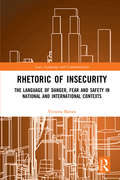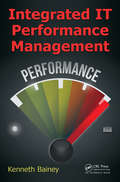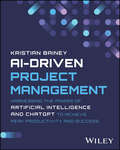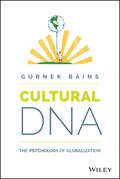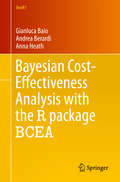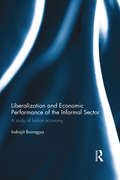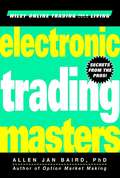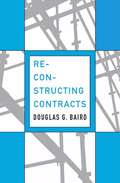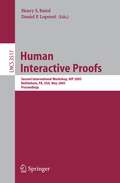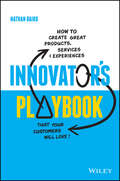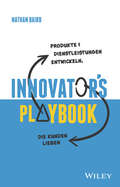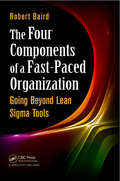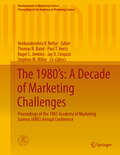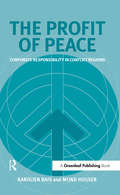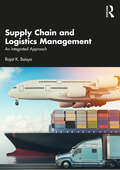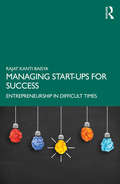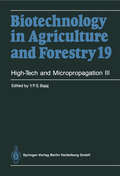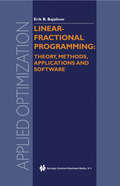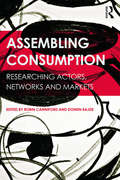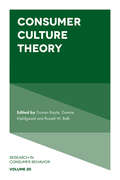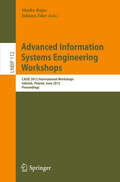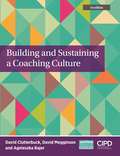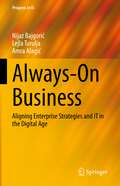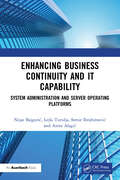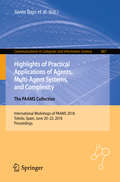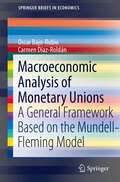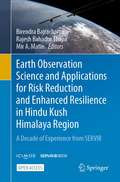- Table View
- List View
Rhetoric of InSecurity: The Language of Danger, Fear and Safety in National and International Contexts (Law, Language and Communication)
by Victoria BainesThis book demands that we question what we are told about security, using tools we have had for thousands of years. The work considers the history of security rhetoric in a number of distinct but related contexts, including the United States’ security strategy, the "war" on Big Tech, and current concerns such as cybersecurity. Focusing on the language of security discourse, it draws common threads from the ancient world to the present day and the near future. The book grounds recent comparisons of Donald Trump to the Emperor Nero in a linguistic evidence base. It examines the potential impact on society of policy-makers’ emphasis on the novelty of cybercrime, their likening of the internet to the Wild West, and their claims that criminals have "gone dark". It questions governments’ descriptions of technology companies in words normally reserved for terrorists, and asks who might benefit. Interdisciplinary in approach, the book builds on existing literature in the Humanities and Social Sciences, most notably studies on rhetoric in Greco-Roman texts, and on the articulation of security concerns in law, international relations, and public policy contexts. It adds value to this body of research by offering new points of comparison, and a fresh but tried and tested way of looking at problems that are often presented as unprecedented. It will be essential to legal and policy practitioners, students of Law, Politics, Media, and Classics, and all those interested in employing critical thinking.
Integrated IT Performance Management
by Kenneth BaineyIf you are in search of real-world practical scenarios of IT performance management practices, with a desire to obtain examples of strategic directives, accountabilities, outcomes, and performance measures for managing IT services, with an interest toward how performance management integrates with strategic and operational management, then Integrat
Integrated IT Performance Management
by Kenneth BaineyIf you are in search of real-world practical scenarios of IT performance management practices, with a desire to obtain examples of strategic directives, accountabilities, outcomes, and performance measures for managing IT services, with an interest toward how performance management integrates with strategic and operational management, then Integrat
AI-Driven Project Management: Harnessing the Power of Artificial Intelligence and ChatGPT to Achieve Peak Productivity and Success
by Kristian BaineyAccelerate your next project with artificial intelligence and ChatGPT In AI-Driven Project Management: Harnessing the Power of Artificial Intelligence and ChatGPT to Achieve Peak Productivity and Success, veteran IT and project management advisor Kristian Bainey delivers an insightful collection of strategies for automating the administration and management of projects. In the book, the author focuses on four key areas where project leaders can achieve improved results with AI's data-centric capabilities: minimizing surprises, minimizing bias, increasing standards, and accelerating decision making. You'll also find: Primers on the role of AI and ChatGPT in Agile, Hybrid, and Predictive approaches to project management How to accurately forecast a project with ChatGPT Techniques for crafting impactful AI strategy using AI project management principles Perfect for managers, executives, and business leaders everywhere, AI-Driven Project Management is also a must-read for project management professionals, tech professionals and enthusiasts, and anyone else interested in the intersection of artificial intelligence, machine learning, and project management.
AI-Driven Project Management: Harnessing the Power of Artificial Intelligence and ChatGPT to Achieve Peak Productivity and Success
by Kristian BaineyAccelerate your next project with artificial intelligence and ChatGPT In AI-Driven Project Management: Harnessing the Power of Artificial Intelligence and ChatGPT to Achieve Peak Productivity and Success, veteran IT and project management advisor Kristian Bainey delivers an insightful collection of strategies for automating the administration and management of projects. In the book, the author focuses on four key areas where project leaders can achieve improved results with AI's data-centric capabilities: minimizing surprises, minimizing bias, increasing standards, and accelerating decision making. You'll also find: Primers on the role of AI and ChatGPT in Agile, Hybrid, and Predictive approaches to project management How to accurately forecast a project with ChatGPT Techniques for crafting impactful AI strategy using AI project management principles Perfect for managers, executives, and business leaders everywhere, AI-Driven Project Management is also a must-read for project management professionals, tech professionals and enthusiasts, and anyone else interested in the intersection of artificial intelligence, machine learning, and project management.
Cultural DNA: The Psychology of Globalization
by Gurnek BainsDevelop deeper cultural intelligence to thrive in a globalized world. Cultural DNA is a thought provoking book for successful engagement with cultures around the world. Written by Gurnek Bains, founder and chairman of a global business psychology consultancy, this book guides leaders through the essential soft skills required to get under the skin and engage an increasingly connected world. Presenting ground breaking original research and the latest evidence from neuroscience, behavioral genetics, and psychology, the deepest instincts of eight key global cultures are dissected. Readers will understand the psychological themes at play in regions such as the U.S., Latin America, Europe, China, India, the Middle East, Sub-Saharan Africa and Australia. Additionally, an extensive database of 30,000 leaders provides insights to inform the reader. The book addresses questions such as: What are the challenges for leaders from different regions as they move into onto the global stage? Why are Americans so positive? Why is China a world leader in manufacturing and India in IT? Why do overseas firms struggle in the U.S. market place? What are the emotional forces driving current events in the Middle East? Each culture has attributes that developed over thousands of years to address unique environmental challenges. This DNA drumbeat from the past reverberates through each society affecting everything. As globalization marches on we can also learn important lessons from the world’s distinct societies. Globalization demands that cultures learn to work within each other's needs and expectations, and the right mix of people skills, business acumen, and cultural awareness is key. Business and Political leaders will understand how each regions’ cultural DNA influences: Its economic and political institutions. People’s underlying consumer psychology. The soft skills needed to lead in that environment. How to best release people’s potential. The issues that need to be managed to anticipate and solve problems before they arise Every now and again a new book comes along, that is a must read: Malcolm Gladwell’s Tipping Point or a Seth Godin’s Tribes. Cultural DNA by Gurnek Bains, by virtue of its depth, originality and ambition, is that very book for all global leaders.
Cultural DNA: The Psychology of Globalization
by Gurnek BainsDevelop deeper cultural intelligence to thrive in a globalized world. Cultural DNA is a thought provoking book for successful engagement with cultures around the world. Written by Gurnek Bains, founder and chairman of a global business psychology consultancy, this book guides leaders through the essential soft skills required to get under the skin and engage an increasingly connected world. Presenting ground breaking original research and the latest evidence from neuroscience, behavioral genetics, and psychology, the deepest instincts of eight key global cultures are dissected. Readers will understand the psychological themes at play in regions such as the U.S., Latin America, Europe, China, India, the Middle East, Sub-Saharan Africa and Australia. Additionally, an extensive database of 30,000 leaders provides insights to inform the reader. The book addresses questions such as: What are the challenges for leaders from different regions as they move into onto the global stage? Why are Americans so positive? Why is China a world leader in manufacturing and India in IT? Why do overseas firms struggle in the U.S. market place? What are the emotional forces driving current events in the Middle East? Each culture has attributes that developed over thousands of years to address unique environmental challenges. This DNA drumbeat from the past reverberates through each society affecting everything. As globalization marches on we can also learn important lessons from the world’s distinct societies. Globalization demands that cultures learn to work within each other's needs and expectations, and the right mix of people skills, business acumen, and cultural awareness is key. Business and Political leaders will understand how each regions’ cultural DNA influences: Its economic and political institutions. People’s underlying consumer psychology. The soft skills needed to lead in that environment. How to best release people’s potential. The issues that need to be managed to anticipate and solve problems before they arise Every now and again a new book comes along, that is a must read: Malcolm Gladwell’s Tipping Point or a Seth Godin’s Tribes. Cultural DNA by Gurnek Bains, by virtue of its depth, originality and ambition, is that very book for all global leaders.
Venture Capital and the European Biotechnology Industry
by W. BainsThis book opens up the world on private equity investment in one of the hottest industries – Biotechnology. The book describes how Europe has fallen behind the US due to under-investment and bad management by the VCs who control the companies. Detailed analysis shows why it is in VCs' interests to damage the very companies they invest in.
Bayesian Cost-Effectiveness Analysis with the R package BCEA (Use R!)
by Gianluca Baio Andrea Berardi Anna HeathThe book provides a description of the process of health economic evaluation and modelling for cost-effectiveness analysis, particularly from the perspective of a Bayesian statistical approach. Some relevant theory and introductory concepts are presented using practical examples and two running case studies. The book also describes in detail how to perform health economic evaluations using the R package BCEA (Bayesian Cost-Effectiveness Analysis). BCEA can be used to post-process the results of a Bayesian cost-effectiveness model and perform advanced analyses producing standardised and highly customisable outputs. It presents all the features of the package, including its many functions and their practical application, as well as its user-friendly web interface. The book is a valuable resource for statisticians and practitioners working in the field of health economics wanting to simplify and standardise their workflow, for example in the preparation of dossiers in support of marketing authorisation, or academic and scientific publications.
Liberalization and Economic Performance of the Informal Sector: A study of Indian Economy
by Indrajit BairagyaImpact of liberalization on informality has been a subject of intense debate for many years and the major issue that has come up is whether liberalization helps to grow informal sector and informality in the economy or it is an obstruction for informal sector’s growth. Thus, in the light of the recent liberalization measure, this book sets to examine general presumptions of the development of informal sector in the context of the Indian economy. The book begins with a broad framework for analysis of output contribution and growth of the informal sector. Liberalization is measured by openness indices and inter-sectoral linkages. Impact of liberalization on growth contributions of informal sector is captured by openness indices (i.e. degree of openness to trade and principal component scores), technical efficiency (measured by Data Envelope Analysis and estimated by Tobit Censored Regression model) and components of productivity (computed by Malmquist total factor productivity index) of the informal enterprises by inter-sectoral linkages. The linkages are modeled theoretically in a neo-classical growth theory and empirically measured by sub-contracting arrangements between formal and informal enterprises. In addition, the book also provides implications on promotion of informal sector from the viewpoint of employment generation. The description and analyses of the book will help with policy implications and enlighten the readers on the development of informal sector.
Liberalization and Economic Performance of the Informal Sector: A study of Indian Economy
by Indrajit BairagyaImpact of liberalization on informality has been a subject of intense debate for many years and the major issue that has come up is whether liberalization helps to grow informal sector and informality in the economy or it is an obstruction for informal sector’s growth. Thus, in the light of the recent liberalization measure, this book sets to examine general presumptions of the development of informal sector in the context of the Indian economy. The book begins with a broad framework for analysis of output contribution and growth of the informal sector. Liberalization is measured by openness indices and inter-sectoral linkages. Impact of liberalization on growth contributions of informal sector is captured by openness indices (i.e. degree of openness to trade and principal component scores), technical efficiency (measured by Data Envelope Analysis and estimated by Tobit Censored Regression model) and components of productivity (computed by Malmquist total factor productivity index) of the informal enterprises by inter-sectoral linkages. The linkages are modeled theoretically in a neo-classical growth theory and empirically measured by sub-contracting arrangements between formal and informal enterprises. In addition, the book also provides implications on promotion of informal sector from the viewpoint of employment generation. The description and analyses of the book will help with policy implications and enlighten the readers on the development of informal sector.
Electronic Trading Masters: Secrets from the Pros!
by Allen Jan BairdDiscover what makes a winner in the trading game Direct access to the markets has changed how individuals trade. It is now possible to compete on a much more level playing field with the pros, knowing who is buying, who is selling, and at what price. Electronic Trading Masters takes traders to the next level by providing advice straight from the mouths of the newest market wizards. The author interviews top traders in today's direct access markets and uncovers their strategies.
Reconstructing Contracts
by Douglas G. BairdDouglas Baird takes stock of the current state of contract doctrine and in the process reinvigorates the classic framework of Anglo-American contract law, showing that Oliver Wendell Holmes’s set of principles, properly understood, continue to provide the best guide to contracts for a new generation of students, practitioners, and judges.
Reconstructing Contracts
by Douglas G. BairdDouglas Baird takes stock of the current state of contract doctrine and in the process reinvigorates the classic framework of Anglo-American contract law, showing that Oliver Wendell Holmes’s set of principles, properly understood, continue to provide the best guide to contracts for a new generation of students, practitioners, and judges.
Human Interactive Proofs: Second International Workshop, HIP 2005, Bethlehem, PA, USA, May 19-20, 2005, Proceedings (Lecture Notes in Computer Science #3517)
by Henry S. Baird Daniel P. LoprestiTelevision and Me: The Memoirs of John Logie Baird
by John Logie Baird‘A fabulous distillation of all the joy and bitterness, hurt and humour of an extraordinary man… I doubt there will be a better written, more interesting or important book published in Scotland this year.’— Daily Mail (2004)‘Funds were going down, the situation was becoming desperate and we were down to our last £30 when at last, one Friday in the first week of October 1925, everything functioned properly. The image of the dummy’s head formed itself on the screen with what appeared to me almost unbelievable clarity. I had got it! I could scarcely believe my eyes, and felt myself shaking with excitement.’In one of the most extraordinary and entertaining autobiographies to be written by any scientist or inventor, John Logie Baird tells the story of his life and the scientific journey which led to the creation of television. He writes with blunt candour and caustic wit about his childhood in Scotland and the wild escapades of his early business career, when he marketed his own patent brand of medicated undersocks, failed in a hilarious attempt to set up a jam-making factory in the Caribbean and went on to sell soap wholesale. Then he gives the definitive account of the epoch-making experiments through which television was created, and his later troubled relationship with the fledgling BBC and his bête noir, Lord Reith, who disliked television. The BBC obstructed and snubbed Baird at every opportunity.Some of his commercial and scientific rivals made a concerted attempt to discredit his status as the central figure in the invention of television, and even today, this has led to his importance being misunderstood. This new edition of his grippingly readable autobiography, edited and introduced by Baird’s only son, Malcolm, will help to set the record straight.
Innovator's Playbook: How to Create Great Products, Services and Experiences that Your Customers Will Love
by Nathan BairdTake a Design-led Approach to Innovation Innovation drives growth in organisations and entire economies. Yet innovation is hard, risky and rarely successful. Most innovations and startups fail because of a lack of focus on the front end of the innovation process where customer needs are researched, insights are distilled, solutions are ideated, prototyped and tested and business models are shaped. But innovation doesn’t have to be this way. In Innovator’s Playbook, author and leading Design Thinking expert Nathan Baird shares his 20 years of hands-on experience, tools and methods for developing a winning customer-centric approach to innovation. This book will teach you how to apply the design thinking method to innovation and help you to innovate better with five practical and proven stages: 1. Build the right team for innovation. 2. Better understand your customer through empathy. 3. Distill and refine customer-centric needs and insights. 4. Unleash your team’s creativity to create fresh new ideas to address customer needs. 5. Experiment and validate desirable, feasible and viable solutions. Innovator’s Playbook helps entrepreneurs, corporate teams, startups and leaders across all levels to use design-led methodologies for start-to-finish innovation success.
Innovator's Playbook: How to Create Great Products, Services and Experiences that Your Customers Will Love
by Nathan BairdTake a Design-led Approach to Innovation Innovation drives growth in organisations and entire economies. Yet innovation is hard, risky and rarely successful. Most innovations and startups fail because of a lack of focus on the front end of the innovation process where customer needs are researched, insights are distilled, solutions are ideated, prototyped and tested and business models are shaped. But innovation doesn’t have to be this way. In Innovator’s Playbook, author and leading Design Thinking expert Nathan Baird shares his 20 years of hands-on experience, tools and methods for developing a winning customer-centric approach to innovation. This book will teach you how to apply the design thinking method to innovation and help you to innovate better with five practical and proven stages: 1. Build the right team for innovation. 2. Better understand your customer through empathy. 3. Distill and refine customer-centric needs and insights. 4. Unleash your team’s creativity to create fresh new ideas to address customer needs. 5. Experiment and validate desirable, feasible and viable solutions. Innovator’s Playbook helps entrepreneurs, corporate teams, startups and leaders across all levels to use design-led methodologies for start-to-finish innovation success.
Innovator's Playbook: Produkte und Dienstleistungen entwickeln, die Kunden lieben
by Nathan BairdInnovation treibt das Wachstum von Organisationen und ganzen Volkswirtschaften an. Doch Innovation ist hart, riskant und selten erfolgreich. Die meisten Innovationen und Neugründungen scheitern an der mangelnden Konzentration auf das Front-End des Innovationsprozesses, wo Kundenbedürfnisse erforscht, Erkenntnisse destilliert, Lösungen entworfen, Prototypen erstellt und getestet und Geschäftsmodelle gestaltet werden. Aber Innovation muss nicht auf diese Weise erfolgen. In "Innovator's Playbook" teilt der Autor und führende Design-Thinking-Experte Nathan Baird seine 20 Jahre praktische Erfahrung. Er stellt Werkzeuge und Methoden vor, die er in Hunderten von erfolgreichen Implementierungen von kundenzentrierter Innovation und kundenzentriertem Design in verschiedenen Branchen und Kontinenten entwickelt hat. Ziel ist die Entwicklung eines erfolgreichen kundenorientierten Innovationsansatzes. In diesem Buch lernen Sie, wie Sie die Design-Thinking-Methode auf Innovation anwenden können. Es hilft Ihnen, in fünf praktischen und bewährten Phasen besser zu innovieren: 1. Stellen Sie das richtige Team für Innovation zusammen. 2. Verstehen Sie Ihren Kunden durch Einfühlungsvermögen besser. 3. Destillieren und verfeinern Sie kundenzentrierte Bedürfnisse und Erkenntnisse. 4. Setzen Sie die Kreativität Ihres Teams frei, um frische neue Ideen zu entwickeln und um Kundenbedürfnisse anzusprechen. 5. Erprobung und Validierung wünschenswerter, durchführbarer und tragfähiger Lösungen. "Innovator's Playbook" hilft Unternehmern, Unternehmensteams, Start-ups und Führungskräften auf allen Ebenen, designorientierte Methoden für den Innovationserfolg von Anfang bis Ende einzusetzen.
The Four Components of a Fast-Paced Organization: Going Beyond Lean Sigma Tools
by Robert BairdIf you examine the characteristics of successful organizations, you will find that speed is a common denominator. Once there is a focus on speed, industry-leading improvements follow, momentum is created, and employees become further engaged to continue executing the strategy.The Four Components of a Fast-Paced Organization: Going Beyond Lean Sigma
The 1980’s: Proceedings of the 1981 Academy of Marketing Science (AMS) Annual Conference (Developments in Marketing Science: Proceedings of the Academy of Marketing Science)
by Thomas R. Baird Paul T. Hertz Roger L. Jenkins Jay D. Linquist Stephen W. MillerThis volume includes the full proceedings from the 1981 Academy of Marketing Science (AMS) Annual Conference held in Miami Beach, Florida with the theme The 1980’s: A Decade of Marketing Challenges. It provides a variety of quality research in the fields of marketing theory and practice in areas such as consumer behaviour, marketing management, marketing education, industrial marketing, and international marketing, among others. Founded in 1971, the Academy of Marketing Science is an international organization dedicated to promoting timely explorations of phenomena related to the science of marketing in theory, research, and practice. Among its services to members and the community at large, the Academy offers conferences, congresses and symposia that attract delegates from around the world. Presentations from these events are published in this Proceedings series, which offers a comprehensive archive of volumes reflecting the evolution of the field. Volumes deliver cutting-edge research and insights, complimenting the Academy’s flagship journals, the Journal of the Academy of Marketing Science (JAMS) and AMS Review. Volumes are edited by leading scholars and practitioners across a wide range of subject areas in marketing science.
The Profit of Peace: Corporate Responsibility in Conflict Regions
by Karolien Bais Mijnd HuijserIt may seem a strange notion to give the private sector a role in conflict prevention or resolution, but multinational corporations (MNCs) do have some characteristics that make them good partners in a well-designed strategy for peace and stability. By focusing on their core competencies, their presence in a conflict region can help to provide prosperity for rebuilding society and its institutions, and improved respect for human rights. This book is not a song of praise for MNCs in general. There is a litany of examples of companies that feel no shame in profiting from conflicts by trading weapons or illegal resources, that prolong war by supporting one or other of the parties, or that are only in a war-torn country because the lawlessness suits them well. Even companies that refrain from such criminal activities cannot be envisaged as potential peace-builders if they profit unscrupulously from cheap labour or cheap subcontractors. Instead, this book is about corporations that are disposed to ethical, responsible entrepreneurship: companies that balance their desire for profit with compliance with international business and human rights standards and with a genuine investment in local workers, environmental protection, social development and stability. Worldwide about 60,000 MNCs work in over 70 conflict regions. They operate in regions where social unrest is harshly repressed, where outright fighting takes place, or where civil war has recently ended. Whatever the attitude of multinationals and whatever their area of business, they influence conflicts or are themselves influenced by conflicts. Even if they do not directly invest in or trade with a conflict region, they always risk being associated with those conflicts. The Profit of Peace examines how multinationals can use their core business competencies to promote peace and stability in conflict regions and what role – if any – business has in diplomacy. To investigate these questions the authors interviewed CEOs and high-level managers of multinationals working in 'challenging' countries such as Afghanistan, Burma and Rwanda. The interviewees provided extraordinarily candid views on both the practical and ethical issues that occur when operating under extremely volatile circumstances. The lessons learned by these managers make the book invaluable for any manager working for a large company in a region of unrest. Two vital elements emerged. Firstly, the ability to manage cultural differences is a key factor for success. Without a keen sense of the differences in management styles, in perceptions of ethics and morality, and in the values behind political opinions, every peace effort is doomed to fail. Secondly, ethically correct decisions do not necessarily lead to ethically correct results. It was not the objective of the authors to judge which of the parties in conflict regions are right or wrong. Rather, they wanted to find out what kind of attitude at the end of the day contributes most effectively to conflict prevention or stabilisation of a region. In other words, in this book corporate responsibility is measured by the results and not by the intentions. All of the CEOs interviewed for this book were well aware of the fact that their companies operating in conflict regions would always influence the conflict one way or another. This awareness in itself is quite extraordinary, and it shows that the indifferent comment "business is business" by and large belongs to a past era. Also extraordinary was that the managers allowed such a frank look into their sanctuary, since this candour makes them all the more vulnerable to criticism. Through the information from the interviewees and from other managers who have experience in conflict regions, the book outlines the ingredients for an approach that can best lead to a solution of conflicts and to greater stability. It will only be in the long run that we will be able to establish how successful the new profession of 'business diplomat' can be, but in the m
The Profit of Peace: Corporate Responsibility in Conflict Regions
by Karolien Bais Mijnd HuijserIt may seem a strange notion to give the private sector a role in conflict prevention or resolution, but multinational corporations (MNCs) do have some characteristics that make them good partners in a well-designed strategy for peace and stability. By focusing on their core competencies, their presence in a conflict region can help to provide prosperity for rebuilding society and its institutions, and improved respect for human rights. This book is not a song of praise for MNCs in general. There is a litany of examples of companies that feel no shame in profiting from conflicts by trading weapons or illegal resources, that prolong war by supporting one or other of the parties, or that are only in a war-torn country because the lawlessness suits them well. Even companies that refrain from such criminal activities cannot be envisaged as potential peace-builders if they profit unscrupulously from cheap labour or cheap subcontractors. Instead, this book is about corporations that are disposed to ethical, responsible entrepreneurship: companies that balance their desire for profit with compliance with international business and human rights standards and with a genuine investment in local workers, environmental protection, social development and stability. Worldwide about 60,000 MNCs work in over 70 conflict regions. They operate in regions where social unrest is harshly repressed, where outright fighting takes place, or where civil war has recently ended. Whatever the attitude of multinationals and whatever their area of business, they influence conflicts or are themselves influenced by conflicts. Even if they do not directly invest in or trade with a conflict region, they always risk being associated with those conflicts. The Profit of Peace examines how multinationals can use their core business competencies to promote peace and stability in conflict regions and what role – if any – business has in diplomacy. To investigate these questions the authors interviewed CEOs and high-level managers of multinationals working in 'challenging' countries such as Afghanistan, Burma and Rwanda. The interviewees provided extraordinarily candid views on both the practical and ethical issues that occur when operating under extremely volatile circumstances. The lessons learned by these managers make the book invaluable for any manager working for a large company in a region of unrest. Two vital elements emerged. Firstly, the ability to manage cultural differences is a key factor for success. Without a keen sense of the differences in management styles, in perceptions of ethics and morality, and in the values behind political opinions, every peace effort is doomed to fail. Secondly, ethically correct decisions do not necessarily lead to ethically correct results. It was not the objective of the authors to judge which of the parties in conflict regions are right or wrong. Rather, they wanted to find out what kind of attitude at the end of the day contributes most effectively to conflict prevention or stabilisation of a region. In other words, in this book corporate responsibility is measured by the results and not by the intentions. All of the CEOs interviewed for this book were well aware of the fact that their companies operating in conflict regions would always influence the conflict one way or another. This awareness in itself is quite extraordinary, and it shows that the indifferent comment "business is business" by and large belongs to a past era. Also extraordinary was that the managers allowed such a frank look into their sanctuary, since this candour makes them all the more vulnerable to criticism. Through the information from the interviewees and from other managers who have experience in conflict regions, the book outlines the ingredients for an approach that can best lead to a solution of conflicts and to greater stability. It will only be in the long run that we will be able to establish how successful the new profession of 'business diplomat' can be, but in the m
Supply Chain and Logistics Management: An Integrated Approach
by Rajat BaisyaThis textbook discusses supply chain management and provides a comprehensive overview of all the key activities and issues of supply chain and logistics functions as an integrated discipline.Taking a comprehensive approach, it reviews end-to-end supply chain management from procurement to production to warehousing, distribution and customer service. It explores how each interface can be managed with the ultimate objective of providing superior customer experience to ensure satisfaction at the least cost while delivering incremental value in a competitive environment.This volume: Guides on designing effective development and management of the supply chain network, which is an invaluable source of sustainable, competitive advantage in today’s turbulent global marketplace Examines the complexities and challenges of catering to the flexible and fluctuating customer demand, warehousing, channel distribution and transportation, global logistics value chain management, and performance management Discusses short practical cases to explain the decision-making process with respect to manufacturing decisions and inventory for efficient working capital management, both of which are critical for supply chain performance Explores performance management matrix, maturity models and so on This book will be useful to students, researchers and faculty from the fields of business management, supply chain and logistics management, and mechanical and civil engineering. It will also be an invaluable companion to consultants and business executives working in the field of supply chain and logistics.
Supply Chain and Logistics Management: An Integrated Approach
by Rajat BaisyaThis textbook discusses supply chain management and provides a comprehensive overview of all the key activities and issues of supply chain and logistics functions as an integrated discipline.Taking a comprehensive approach, it reviews end-to-end supply chain management from procurement to production to warehousing, distribution and customer service. It explores how each interface can be managed with the ultimate objective of providing superior customer experience to ensure satisfaction at the least cost while delivering incremental value in a competitive environment.This volume: Guides on designing effective development and management of the supply chain network, which is an invaluable source of sustainable, competitive advantage in today’s turbulent global marketplace Examines the complexities and challenges of catering to the flexible and fluctuating customer demand, warehousing, channel distribution and transportation, global logistics value chain management, and performance management Discusses short practical cases to explain the decision-making process with respect to manufacturing decisions and inventory for efficient working capital management, both of which are critical for supply chain performance Explores performance management matrix, maturity models and so on This book will be useful to students, researchers and faculty from the fields of business management, supply chain and logistics management, and mechanical and civil engineering. It will also be an invaluable companion to consultants and business executives working in the field of supply chain and logistics.
Managing Start-ups for Success: Entrepreneurship in Difficult Times
by Rajat Kanti BaisyaWorld economics and the industrial environment has recently created a fertile ground for the creation of new enterprises and start-ups. This book skilfully identifies the challenges of building a new business venture from an idea to a marketable product. It highlights • Robust methods for keeping up with innovation; • Designing new ways to grow, improve and market your product; and • Managing the changes in the business environment, market dynamics and other uncertainties. The volume is rich with examples and case studies of many small and large businesses. It further reflects on the business and entrepreneurship ecosystem, the challenges and opportunities in India, entrepreneurship and women, e-commerce, the new generation of entrepreneurs, and exit strategies for entrepreneurs. An essential guide for entrepreneurs and professionals working in business management and marketing communications, as well as scholars of business administration and financial sciences, this book by an industry expert offers many new and practiced approaches, examples and lessons for innovative thinking and breaking new ground in business.
Managing Start-ups for Success: Entrepreneurship in Difficult Times
by Rajat Kanti BaisyaWorld economics and the industrial environment has recently created a fertile ground for the creation of new enterprises and start-ups. This book skilfully identifies the challenges of building a new business venture from an idea to a marketable product. It highlights • Robust methods for keeping up with innovation; • Designing new ways to grow, improve and market your product; and • Managing the changes in the business environment, market dynamics and other uncertainties. The volume is rich with examples and case studies of many small and large businesses. It further reflects on the business and entrepreneurship ecosystem, the challenges and opportunities in India, entrepreneurship and women, e-commerce, the new generation of entrepreneurs, and exit strategies for entrepreneurs. An essential guide for entrepreneurs and professionals working in business management and marketing communications, as well as scholars of business administration and financial sciences, this book by an industry expert offers many new and practiced approaches, examples and lessons for innovative thinking and breaking new ground in business.
Sustainable Built Environment: Select Proceedings of ICSBE 2023 (Lecture Notes in Civil Engineering #451)
by Deepak Bajaj Thayaparan Gajendran Sanjay PatilThis book presents the select proceedings of International Conference on Sustainable Built Environment (ICSBE 2023). It discusses the issues of sustainability and resilience in all types of building projects, construction projects, operational building, and infrastructure projects within urban regions of the world. The key themes covered in this book are sustainable urban planning, sustainable construction, real estate, housing, net-zero built environment, climate change policy, legal framework, climate finance, technology, and innovation toward decarbonization of the built environment. This book is useful for researchers and professionals working in the fields of construction management, built environment, and allied fields.
Trees II (Biotechnology in Agriculture and Forestry #5)
by Y. P. Bajaj'frees contribute a major part of fuel, fodder and fruit, and are an im of bioenergy. They are now needed in large numbers more portant source than ever before for afforestation and social forestry, so that fast-grow ing and multipurpose trees assume great importance. After extensive in discriminate deforestation and rapid depletion of genetic stocks, efforts are now being made to evolve methods for clonal mass propagation of improved and elite trees. Production of short-duration trees with a rapid turnover of biomass, and induction of genetic variability through in vitro manipulation for the production of novel fruit and forest trees, which are high-yielding and resistant to pests and diseases, and trees which display increased photosynthetic efficiency are in demand. These objectives are well within the realm of horticultural and forest biotech nology. Some of the recent advances, such as the regeneration of com plete trees from isolated protoplasts, somatic hybridization, and the Agrobacterium-mediated transformation in various tree species have opened new vistas for the genetic engineering of fruit and forest trees. This book is a continuation of the earlier volume Trees I, and presents 31 chapters on fruit, forest, nut and ornamental trees, such as avocado, pineapple, crabapple, quince, pistachio, walnut, hazelnut, date palm, oil palm, cacao, rubber, maple, sweet-gum, poplars, birches, Chinese tallow, willows, oaks, paper mulberry, rhododendrons, Scots pine, Calabrian pine, Douglas-fir, redwood, ginkgo, cycads and some flowering trees.
Linear-Fractional Programming Theory, Methods, Applications and Software (Applied Optimization #84)
by E.B. BajalinovThis is a book on Linear-Fractional Programming (here and in what follows we will refer to it as "LFP"). The field of LFP, largely developed by Hungarian mathematician B. Martos and his associates in the 1960's, is concerned with problems of op timization. LFP problems deal with determining the best possible allo cation of available resources to meet certain specifications. In particular, they may deal with situations where a number of resources, such as people, materials, machines, and land, are available and are to be combined to yield several products. In linear-fractional programming, the goal is to determine a per missible allocation of resources that will maximize or minimize some specific showing, such as profit gained per unit of cost, or cost of unit of product produced, etc. Strictly speaking, linear-fractional programming is a special case of the broader field of Mathematical Programming. LFP deals with that class of mathematical programming problems in which the relations among the variables are linear: the con straint relations (i.e. the restrictions) must be in linear form and the function to be optimized (i.e. the objective function) must be a ratio of two linear functions.
Assembling Consumption: Researching actors, networks and markets
by Domen Bajde Robin CannifordAssembling Consumption marks a definitive step in the institutionalisation of qualitative business research. By gathering leading scholars and educators who study markets, marketing and consumption through the lenses of philosophy, sociology and anthropology, this book clarifies and applies the investigative tools offered by assemblage theory, actor-network theory and non-representational theory. Clear theoretical explanation and methodological innovation, alongside empirical applications of these emerging frameworks will offer readers new and refreshing perspectives on consumer culture and market societies. This is an essential reading for both seasoned scholars and advanced students of markets, economies and social forms of consumption.
Assembling Consumption: Researching actors, networks and markets
by Domen Bajde Robin CannifordAssembling Consumption marks a definitive step in the institutionalisation of qualitative business research. By gathering leading scholars and educators who study markets, marketing and consumption through the lenses of philosophy, sociology and anthropology, this book clarifies and applies the investigative tools offered by assemblage theory, actor-network theory and non-representational theory. Clear theoretical explanation and methodological innovation, alongside empirical applications of these emerging frameworks will offer readers new and refreshing perspectives on consumer culture and market societies. This is an essential reading for both seasoned scholars and advanced students of markets, economies and social forms of consumption.
Consumer Culture Theory (Research in Consumer Behavior #20)
by Domen Bajde Dannie Kjeldgaard Russell W. BelkThe twentieth volume of Research in Consumer Behavior presents twelve chapters, selected from the best papers submitted at the 13th annual Consumer Culture Theory Conference held in Denmark in June 2018. Aligned with the conference's thematic emphasis on storytelling, the contributors' research stories open the eyes and minds of readers to thought-provoking ideas, theories, and contexts. This book will allow researchers and graduate students working in the area of consumer research and marketing to explore three narrative lines that were prevalent during the conference: 'Objects and their doings', 'Glocalization', and 'Constituting Markets'. The volume concludes with an awarded paper by Brown, who takes a critical look at the quality of storytelling in the CCT tradition and helps us learn from the great storytellers of the past.
Advanced Information Systems Engineering Workshops: CAiSE 2012 International Workshops, Gdańsk, Poland, June 25-26, 2012, Proceedings (Lecture Notes in Business Information Processing #112)
by Marko Bajec Johann EderThis book constitutes the thoroughly refereed proceedings of eight international workshops held in Gdańsk, Poland, in conjunction with the 24th International Conference on Advanced Information Systems Engineering, CAiSE 2012, in June 2012.The 35 full and 17 short revised papers were carefully selected from 104 submissions. The eight workshops were Agility of Enterprise Systems (AgilES), Business/IT Alignment and Interoperability (BUSITAL), Enterprise and Organizational Modeling and Simulation (EOMAS), Governance, Risk and Compliance (GRCIS), Human-Centric Process-Aware Information Systems (HC-PAIS), System and Software Architectures (IWSSA), Ontology, Models, Conceptualization and Epistemology in Social, Artificial and Natural Systems (ONTOSE), and Information Systems Security Engineering (WISSE).
Building and Sustaining a Coaching Culture
by Agnieszka Bajer David Clutterbuck David MegginsonBuilding and Sustaining a Coaching Culture is the ideal book for everyone who is passionate about coaching and who has an interest in creating an environment that supports learning and growth. Easy to navigate and logically structured, topics include the current understanding of coaching culture in organisations, coaching and mentoring culture strategy, making effective use of external coaches, formal and informal mentoring, developing and supporting internal coaches and mentors, team coaching, cross-cultural marketing coaching and cross-cultural issues. This edition of Building and Sustaining a Coaching Culture is a fully revised version of the seminal book Making Coaching Work: Creating a Coaching Culture. It analyses what has changed in the field of coaching culture and provides update on new knowledge and experience. A wide variety of international case studies and engaging tools such as chapter overviews, templates, and reflective questions will take you clearly through the development and implementation of a successful and integrated training culture. Whether you are an HR Manager looking to maximise the positive impact of coaching in your organisation, a business leader wanting to facilitate growth, or a consultant or coach seeking to place your work in the relevant organisational context, you will be shown how to implement an effective coaching and mentoring strategy that meets your needs.
Building and Sustaining a Coaching Culture
by Agnieszka Bajer David Clutterbuck David MegginsonBuilding and Sustaining a Coaching Culture is the ideal book for everyone who is passionate about coaching and who has an interest in creating an environment that supports learning and growth. Easy to navigate and logically structured, topics include the current understanding of coaching culture in organisations, coaching and mentoring culture strategy, making effective use of external coaches, formal and informal mentoring, developing and supporting internal coaches and mentors, team coaching, cross-cultural marketing coaching and cross-cultural issues. This edition of Building and Sustaining a Coaching Culture is a fully revised version of the seminal book Making Coaching Work: Creating a Coaching Culture. It analyses what has changed in the field of coaching culture and provides update on new knowledge and experience. A wide variety of international case studies and engaging tools such as chapter overviews, templates, and reflective questions will take you clearly through the development and implementation of a successful and integrated training culture. Whether you are an HR Manager looking to maximise the positive impact of coaching in your organisation, a business leader wanting to facilitate growth, or a consultant or coach seeking to place your work in the relevant organisational context, you will be shown how to implement an effective coaching and mentoring strategy that meets your needs.
Always-On Business: Aligning Enterprise Strategies and IT in the Digital Age (Progress in IS)
by Nijaz Bajgorić Lejla Turulja Amra AlagićModern business relies heavily on information technology. This book presents a new “always-on” business model for the digital age, one based on three interrelated components: a business model, an IT capability model, and an always-on information system model. In addition, it develops an implementation framework for the new model by identifying business-critical continuous computing information technologies as implementation drivers.The model proposed in this book reveals the critical role of business continuity management in ensuring business continuity even when operations are unaffected by any disasters. Using empirical survey data, PLS-SEM (Partial Least Squares - Structural Equation Modeling) combined with mediation analysis are used to test the model and hypotheses.The book is chiefly intended for students in Business Administration/Management degree programs and business leaders whose work involves addressing issues such as organizational performance, IT capability, enterprise information systems, IT management, business continuity management, disaster recovery management, risk management, IT auditing, and compliance.
Enhancing Business Continuity and IT Capability: System Administration and Server Operating Platforms
by Nijaz Bajgorić Lejla Turulja Semir Ibrahimović Amra AlagićEnterprise servers play a mission-critical role in modern computing environments, especially from a business continuity perspective. Several models of IT capability have been introduced over the last two decades. Enhancing Business Continuity and IT Capability: System Administration and Server Operating Platforms proposes a new model of IT capability. It presents a framework that establishes the relationship between downtime on one side and business continuity and IT capability on the other side, as well as how system administration and modern server operating platforms can help in improving business continuity and IT capability. This book begins by defining business continuity and IT capability and their importance in modern business, as well as by giving an overview of business continuity, disaster recovery planning, contingency planning, and business continuity maturity models. It then explores modern server environments and the role of system administration in ensuring higher levels of system availability, system scalability, and business continuity. Techniques for enhancing availability and business continuity also include Business impact analysis Assessing the downtime impact Designing an optimal business continuity solution IT auditing as a process of gathering data and evidence to evaluate whether the company’s information systems infrastructure is efficient and effective and whether it meets business goals The book concludes with frameworks and guidelines on how to measure and assess IT capability and how IT capability affects a firm’s performances. Cases and white papers describe real-world scenarios illustrating the concepts and techniques presented in the book.
Enhancing Business Continuity and IT Capability: System Administration and Server Operating Platforms
by Nijaz Bajgorić Lejla Turulja Semir Ibrahimović Amra AlagićEnterprise servers play a mission-critical role in modern computing environments, especially from a business continuity perspective. Several models of IT capability have been introduced over the last two decades. Enhancing Business Continuity and IT Capability: System Administration and Server Operating Platforms proposes a new model of IT capability. It presents a framework that establishes the relationship between downtime on one side and business continuity and IT capability on the other side, as well as how system administration and modern server operating platforms can help in improving business continuity and IT capability. This book begins by defining business continuity and IT capability and their importance in modern business, as well as by giving an overview of business continuity, disaster recovery planning, contingency planning, and business continuity maturity models. It then explores modern server environments and the role of system administration in ensuring higher levels of system availability, system scalability, and business continuity. Techniques for enhancing availability and business continuity also include Business impact analysis Assessing the downtime impact Designing an optimal business continuity solution IT auditing as a process of gathering data and evidence to evaluate whether the company’s information systems infrastructure is efficient and effective and whether it meets business goals The book concludes with frameworks and guidelines on how to measure and assess IT capability and how IT capability affects a firm’s performances. Cases and white papers describe real-world scenarios illustrating the concepts and techniques presented in the book.
ArcGIS for Environmental and Water Issues (Springer Textbooks in Earth Sciences, Geography and Environment)
by William BajjaliThis textbook is a step-by-step tutorial on the applications of Geographic Information Systems (GIS) in environmental and water resource issues. It provides information about GIS and its applications, specifically using the most advanced ESRI GIS technology and its extensions. Eighteen chapters cover GIS applications in the field of earth sciences and water resources in detail from the ground up. Author William Bajjali explains what a GIS is and what it is used for, the basics of map classification, data acquisition, coordinate systems and projections, vectorization, geodatabase and relational database, data editing, geoprocessing, suitability modeling, working with raster, watershed delineation, mathematical and statistical interpolation, and more advanced techniques, tools and extensions such as ArcScan, Topology, Geocoding, Hydrology, Geostatistical Analyst, Spatial Analyst, Network Analyst, 3-D Analyst. ArcPad, ESRI’s cutting-edge mobile GIS software, is covered in detail as well. Each chapter contains concrete case studies and exercises – many from the author’s own work in the United States and Middle East. This volume is targeted toward advanced undergraduates, but could also be useful for professionals and for anyone who utilizes GIS or practices spatial analysis in relation to geology, hydrology, ecology, and environmental sciences.
Highlights of Practical Applications of Agents, Multi-Agent Systems, and Complexity: International Workshops of PAAMS 2018, Toledo, Spain, June 20–22, 2018, Proceedings (Communications in Computer and Information Science #887)
by Javier Bajo Juan M. Corchado Elena María Navarro Martínez Eneko Osaba Icedo Philippe Mathieu Patrycja Hoffa-Dąbrowska Elena Del Val Sylvain Giroux Antonio J. M. Castro Nayat Sánchez-Pi Vicente Julián Ricardo Azambuja Silveira Alberto Fernández Rainer Unland Rubén Fuentes-FernándezThis book constitutes the refereed proceedings of the 11 workshops co-located with the 16th International Conference on Practical Applications of Agents and Multi-Agent Systems, PAAMS 2018, held in Toledo, Spain, in June 2018. The 47 full papers presented were carefully reviewed and selected from 72 submissions. The volume presents the papers that have been accepted for the following workshops: Workshop on Agents and Multi-agent Systems for AAL and e-HEALTH; Workshop on Agent based Applications for Air Transport; Workshop on Agent-based Artificial Markets Computational Economics; Workshop on Agent-Based Solutions for Manufacturing and Supply Chain; Workshop on MAS for Complex Networks and Social Computation; Workshop on Intelligent Systems and Context Information Fusion; Workshop on Multi-agent based Applications for Energy Markets, Smart Grids and Sustainable Energy Systems; Workshop on Multiagent System based Learning Environments; Workshop on Smart Cities and Intelligent Agents; Workshop on Swarm Intelligence and Swarm Robotics; Workshop on Multi-Agent Systems and Simulation.
Die Schuldenbremse: Politische Kritik des Staatsschuldenrechts (essentials)
by Stefan BajohrIn diesem Essential geht es um die Entstehungsgeschichte der Schuldenbremse. Der Autor stellt dar, warum die Schuldenbremse das Staatsschuldenrecht verkompliziert und die Parlamente entmündigt. Als das Wirtschaftswachstum in den 1970er Jahren nachließ, stand die Politik vor der Aufgabe, die Erwerbslosigkeit zu bekämpfen und den Sozialstaat zu bewahren. Öffentliche Investitionen, finanziert durch Staatsverschuldung, boten sich als scheinbare Lösung an. Dadurch wuchs ein Schuldenberg von mehr als zwei Billionen Euro heran. Bei etlichen europäischen Nachbarn hat sich die Verschuldung zur Staatsschuldenkrise gesteigert. Die Zinsen engen die Entscheidungsspielräume der Politik ein und verteilen den gesellschaftlichen Reichtum von unten nach oben um. 2009 wurde eine so genannte Schuldenbremse im Grundgesetz verankert. Sie soll von den Euroländern übernommen werden. Damit die Schuldenbremse nicht als Hebel zum Abbau des Sozialstaats dienen kann, braucht es einen leistungsfähigen Staat mit solider Steuerfinanzierung.
Macroeconomic Analysis of Monetary Unions: A General Framework Based on the Mundell-Fleming Model (SpringerBriefs in Economics)
by Oscar Bajo-Rubio Carmen Díaz-RoldánThe book develops a general framework for the macroeconomic modeling of monetary unions. The starting point of the analysis is the standard two-country Mundell-Fleming model with perfect capital mobility, extended to incorporate the supply side in a context of rigid real wages, and modified so that the money market is common for two countries forming a monetary union. The model is presented in two versions: for a small and a large monetary union, respectively. After solving each model, the authors derive multipliers for monetary, expenditure, supply, and external shocks, both in the short and the long run; a graphical analysis is also provided. Special attention is paid to the crucial distinction between symmetric and asymmetric shocks.
Fourth Generation Biofuels (SpringerBriefs in Applied Sciences and Technology)
by Pratima BajpaiThis book examines the background of fourth-generation biofuel production, use of genetically modified microalgae for production of fourth-generation biofuels; cultivation and harvesting of genetically modified microalgae; residue from biofuel extraction; health and environmental concerns of fourth-generation biofuels; regulations on cultivation and processing of the genetically modified algae; carbon dioxide sequestration; water footprint and current status and key challenges. The topic caters to academic researchers and industrial experts, who work in the field of biofuels as source of alternative fuel to achieve environmental and economic sustainability.
Third Generation Biofuels (SpringerBriefs in Energy)
by Pratima BajpaiGrowing concerns about the rapid depletion of fossil fuel reserves, rising crude oil prices, energy security and global climate change have led to increased worldwide interest in renewable energy sources such as biofuels. In this context, biofuel production from renewable sources is considered to be one of the most sustainable alternatives to fossil fuels and a viable means of achieving environmental and economic sustainability. Although biofuel processes hold great potential to provide a carbon-neutral route to fuel production, first-generation production systems are characterized by considerable economic and environmental limitations. The advent of second-generation biofuels is intended to produce fuels from lignocellulosic biomass, the woody part of plants that does not compete with food production. However, converting woody biomass into fermentable sugars requires costly technologies. Therefore, third-generation biofuels from microalgae are considered to be a viable alternative energy resource, free from the major drawbacks associated with first and second-generation biofuels. This book examines the background of third-generation biofuel production; the advantages of algae over traditional biofuel crops; algal biomass production; algae harvesting and drying methods; production of biofuel from microalgae; and future prospects.
Earth Observation Science and Applications for Risk Reduction and Enhanced Resilience in Hindu Kush Himalaya Region: A Decade of Experience from SERVIR
by Birendra Bajracharya Rajesh Bahadur Thapa Mir A. MatinThis open access book is a consolidation of lessons learnt and experiences gathered from our efforts to utilise Earth observation (EO) science and applications to address environmental challenges in the Hindu Kush Himalayan region. It includes a complete package of knowledge on service life cycles including multi-disciplinary topics and practically tested applications for the HKH. It comprises 19 chapters drawing from a decade’s worth of experience gleaned over the course of our implementation of SERVIR-HKH – a joint initiative of NASA, USAID, and ICIMOD – to build capacity on using EO and geospatial technology for effective decision making in the region. The book highlights SERVIR’s approaches to the design and delivery of information services – in agriculture and food security; land cover and land use change, and ecosystems; water resources and hydro-climatic disasters; and weather and climate services. It also touches upon multidisciplinary topics such as service planning; gender integration; user engagement; capacity building; communication; and monitoring, evaluation, and learning. We hope that this book will be a good reference document for professionals and practitioners working in remote sensing, geographic information systems, regional and spatial sciences, climate change, ecosystems, and environmental analysis. Furthermore, we are hopeful that policymakers, academics, and other informed audiences working in sustainable development and evaluation – beyond the wider SERVIR network and well as within it – will greatly benefit from what we share here on our applications, case studies, and documentation across cross-cutting topics.
Personal Finance
by null Vickie L. BajtelsmitPersonal Finance, 3rd Edition offers essential skills and knowledge that will set students on the road to lifelong financial wellness. Byfocusing on real-world decision making, Bajtelsmit Personal Finance engages a diverse student population by helping them make personal connections that can immediately impact their current financial situations. Using a conversational writing style, relatable examples, and up-to-date coverage on important topics – such as student debt, housing, fintech and AI – students gain the knowledge they need to avoid early financial mistakes. By the end of the course, students have identified their goals and developed the problem-solving skills they need to build on as they progress to the next stages of life.
Wiley Pathways Personal Finance
by Vickie L. Bajtelsmit Linda G. RastelliPersonal Finance, the latest text in the business series in the Wiley Pathways imprint, helps students learn to budget, manage taxes, consumer credit, and loans while also providing the knowledge and skills needed to make good financial decisions including, automobiles or housing purchases and leases, investing in stocks and bonds, and planning for retirement.
